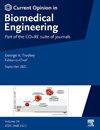Hyaluronic acid-based models of the brain microenvironment: Challenges and advances
IF 4.2
3区 工程技术
Q2 ENGINEERING, BIOMEDICAL
引用次数: 0
Abstract
While hyaluronic acid (HA) extracellular matrix (ECM) models continue to provide valuable insights into brain physiology and disease, much room for improvement remains in terms of capturing the cellular and structural complexity of the brain microenvironment. Here we review next-generation HA models that are aimed at better capturing brain microenvironmental complexity. We discuss functionalization and crosslinking strategies designed to improve HA stability and biocompatibility. We also cover efforts to incorporate ECM proteins and stromal elements into HA hydrogels, including astrocytes, endothelial cells, and macrophages. We conclude with a brief discussion of nascent advancements and applications of these models, ranging from the reconstruction of multicellular stromal structures to the development of high-throughput screening platforms. This new suite of matrix technologies and the resulting applications should contribute greatly to mechanistic and therapeutic discovery in brain physiology and disease.
基于透明质酸的大脑微环境模型:挑战和进展
虽然透明质酸(HA)细胞外基质(ECM)模型继续为大脑生理学和疾病提供有价值的见解,但在捕捉大脑微环境的细胞和结构复杂性方面仍有很大的改进空间。在这里,我们回顾旨在更好地捕捉大脑微环境复杂性的下一代HA模型。我们讨论功能化和交联策略,旨在提高透明质酸的稳定性和生物相容性。我们还介绍了将ECM蛋白和基质元素纳入透明质酸水凝胶的努力,包括星形胶质细胞、内皮细胞和巨噬细胞。最后,我们简要讨论了这些模型的新进展和应用,从多细胞基质结构的重建到高通量筛选平台的发展。这套新的基质技术和由此产生的应用将极大地促进脑生理学和疾病的机制和治疗发现。
本文章由计算机程序翻译,如有差异,请以英文原文为准。
求助全文
约1分钟内获得全文
求助全文
来源期刊

Current Opinion in Biomedical Engineering
Medicine-Medicine (miscellaneous)
CiteScore
8.60
自引率
2.60%
发文量
59
 求助内容:
求助内容: 应助结果提醒方式:
应助结果提醒方式:


